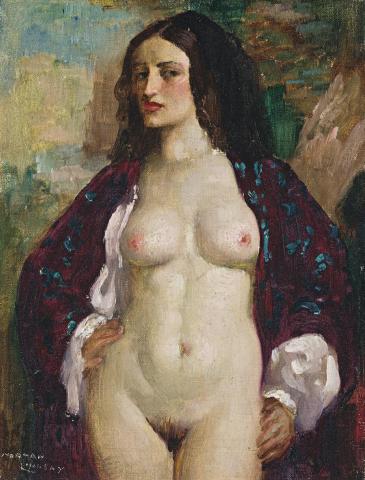THE BLACK CLOAK, c.1935
NORMAN LINDSAY
oil on canvas
31.0 x 24.0 cm
signed lower left: NORMAN / LINDSAY
Estate of Margaret Coen (Mrs Douglas Stewart)
Private collection, Adelaide
This work is accompanied by a certificate of authenticity signed by Jane Bloomfield, Director, Bloomfield Galleries.
For Norman Lindsay the human figure was the most beautiful thing in the world. It is therefore not surprising that the female form, firm of breast and bright of eye, played the leading role in his art. With wowserism fixed in his sight, he used her both naked and tantalisingly clad to fight the narrow-minded puritanism and prudery of his day. For over twenty-five years his favourite model was Rose, his second wife, whose faired-haired features and figure appealed to him greatly. Often Junoesque in appearance, she was the central character in many of his greatest works, based on subjects from the ancient classics of Greece and Rome, to buccaneers, and the pleasure loving English Restoration of Charles II. The exotic, dark-haired Rita, who modelled for his oil paintings from the 1930s onwards, followed Rose. Lindsay considered her to be the perfect model for oil painting.1 The model in The Black Cloak c1935 was another of Lindsay's favourites, the artist Margaret Coen (1909 - 1993). Coen studied at the Royal Art School, Sydney during the 1920s under Dattilo-Rubbo and Sydney Long, becoming a member of Sydney's bohemian society. A noted watercolourist, she was introduced to the medium by Lindsay when she visited him at Springwood in 1930. 'I had gone to see Norman expecting to learn about black and white; I came away determined to become a watercolourist.'2 Lindsay painted a watercolour of her, while Coen 'had stars in her eyes for Norman right from the start.'3 Lindsay was like inclined. With Coen a frequent painter-visitor to Springwood, they became lovers. When the affair ended in 1939 their relationship changed into friendship, strengthened by Coen's marriage in 1945 to Douglas Stewart, already and remaining Lindsay's closest friend. Stewart wrote of Lindsay - 'He paints women as if they were goddesses.'4
The Black Cloak was painted during the time of their affair, the outdoor setting suggesting the gardens at Springwood. The full frontal pose is characteristically Lindsay. Years later, Meg Stewart wrote a biography of her mother, updating it recently to include a revealing new chapter on her mother's friendship with Lindsay. Lindsay's daughter Jane described Coen to Meg as '...a very beautiful, gentle creature.'5 Meg herself referring to her mother as having 'milk-white skin, blue eyes and black hair'6 It was no one sided affair, Lin Bloomfield noting that it 'revived and revitalised [Norman's] creative facility'.7 Bloomfield also detailed the ongoing love triangle of Lindsay, Rose, and Coen in several of his etchings of the thirties. The life-long friendship between Lindsay and Coen is currently being commemorated by the exhibition A Passion for Colours -The Colours of Margaret Coen, at the Norman Lindsay Gallery and Museum, Faulconbridge until 31 August.
1. Lindsay, N., My Mask: For what little I know of the man behind it, an autobiography, Angus & Robertson, Sydney, 1970, p. 241
2. Stewart, M., Autobiography of My Mother, Vintage Books, Australia, 2007, p. 170
3. Lin Bloomfield quoted ibid., p. 329
4. Stewart, D., The Flesh and the Spirit, Angus and Robertson, Sydney, 1948, p. 277
5. Stewart, M., ibid., p. 324
6. ibid., p. 330
7. Bloomfield quoted in ibid., p. 325
DAVID THOMAS
